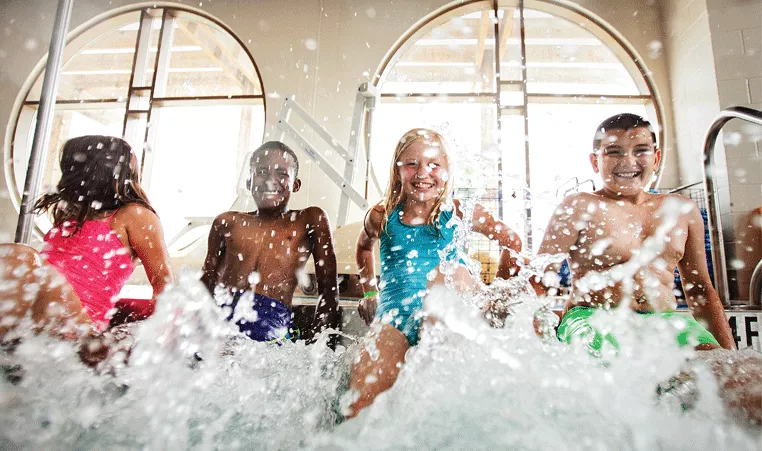
Years before he became a U.S. Olympic swimmer, Cullen Jones almost drowned in front of his parents.
Young Cullen loved the water. He happily spent hours in the bathtub, “until I was a prune,” he recalls. At age 5, his parents took him to a water park in Pennsylvania. His father slid down a water slide in an inner tube, followed by a gleeful Cullen. His joy quickly turned to terror. “I flipped upside down,” Jones, now 33, says. “Underwater, I held onto the inner tube, trying to pull myself up, but I didn’t have the strength.” Cullen lost consciousness; a lifeguard rescued and helped resuscitate him.
The terrifying episode prompted Jones’ parents to take him to swimming lessons. Jones – who won a gold medal as part of a U.S. men’s freestyle relay team in the 2008 London Olympic Games – recounts his near-drowning as part of his efforts to encourage kids, adolescents, teenagers and adults to learn to swim on behalf of the USA Swimming Foundation's “Make a Splash” program. He and other proponents of swimming and water safety point out that every year, about 3,500 people in the U.S. accidentally drown, according to the Centers for Disease Control and Prevention.
Swimming programs not only teach people how to swim, but they also provide other safety training, such as cardiopulmonary resuscitation lessons, demonstrations of how to use safety equipment, such as flotation devices, and tips on safer places to swim.
Outreach efforts by the USA Swimming Foundation (which works with hundreds of local pools), the YMCA and hundreds of local recreation programs are making a difference, says Debbie Hesse, executive director of USA Swimming Foundation. The foundation recently released a new study by the University of Memphis and the University of Nevada-Las Vegas measuring the swimming ability of kids ages 4 to 18 and parents and other caregivers in the U.S. Within this group, the study found that 64 percent of African-Americans, 45 percent of Hispanics and 40 percent of Caucasians have little or no swimming ability, which puts them at risk for drowning. Those numbers may not sound great, but they’re an improvement of 5 to 10 percent (depending on the group) over a 2010 survey released by the foundation. That survey found that 70 percent of African-Americans had little or no swimming ability.
A 2014 study by the CDC found that the rate of drowning in swimming pools for black kids and teens between ages 5 and 19 is more than five times that of white children. This lack of swimming ability has led to some high-profile tragedies: In August 2010, for example, a black teenager wading along the Red River shoreline near Shreveport, Louisiana, slipped off a ledge into deeper water. The teen didn’t know how to swim and yelled for help. Five siblings and cousins rushed into the water to save him – but none of them could swim, either. All six drowned.
Pre-civil rights era Jim Crow policies account for why relatively few African-Americans have learned how to swim, says Jeff Wiltse, a history professor at the University of Montana who wrote “The Black-White Swimming Disparity in America: A Deadly Legacy of Swimming Pool Discrimination,” published in 2014 in the Journal of Sport and Social Issues. He also wrote the book “Contested Waters: A Social History of Swimming Pools in America.”
“The comparatively low swimming rates among black Americans today is, in large part, a legacy of past discrimination. Swimming became popularized among white Americans in the 1920s and 1930s at municipal swimming pools and in the 1950s and 1960s at suburban club pools,” Wiltse says. “Black Americans were largely denied access to these pools and the swim lessons that occurred at them. As a result, swimming never became integral to black Americans’ recreation and sports culture and was not passed down from generation to generation as commonly occurred with whites. In many cases, black parents passed along a fear of water to their children rather than the practice of swimming. In this way, the swimming disparity created by past discrimination persists to the present.”
Jones, one of the most prominent African-American swimmers in U.S. history, hopes he and other black swimmers can serve as role models for black youths. Jones wants blacks and everyone else to not only learn swimming for safety reasons, but to improve their health. Swimming is great exercise that's easy on the joints, so it’s excellent for people with arthritis. It doesn’t take a toll on your feet or legs the way high-impact exercise can. Swimming can also help ward off diabetes, obesity and heart disease. “The ball is rolling, but there’s a lot more work to be done,” Jones says.
Source: US News and World Report